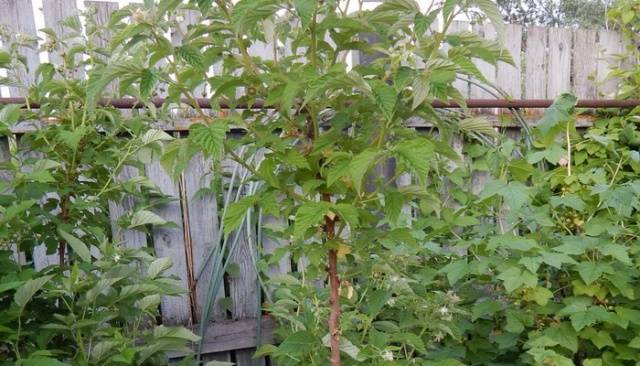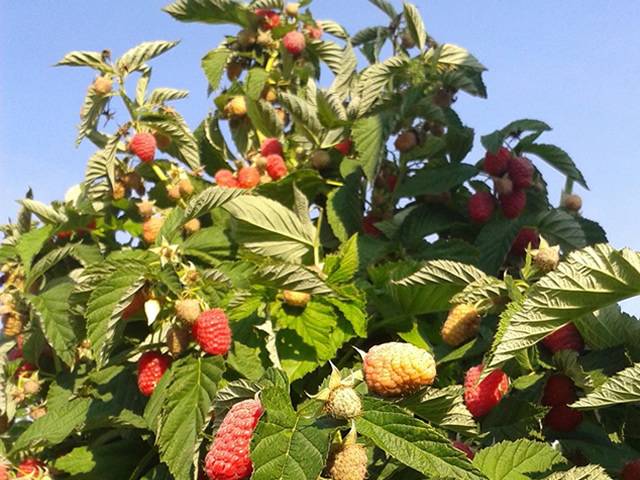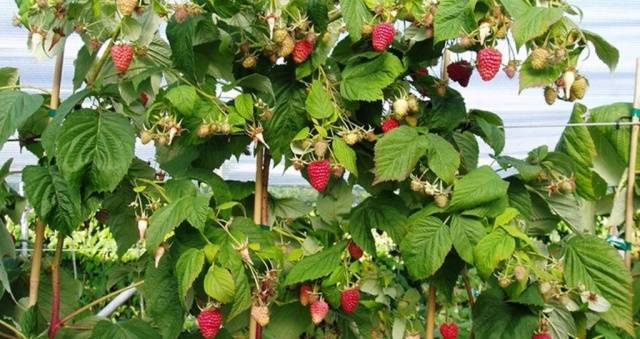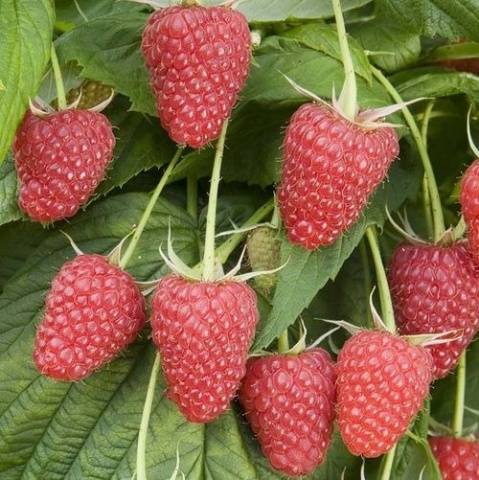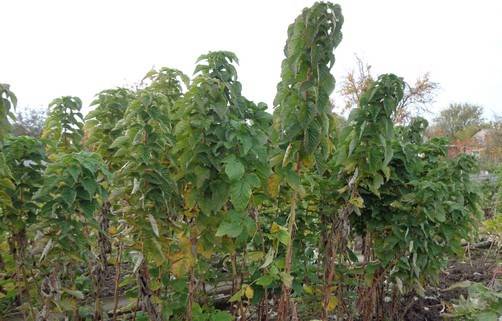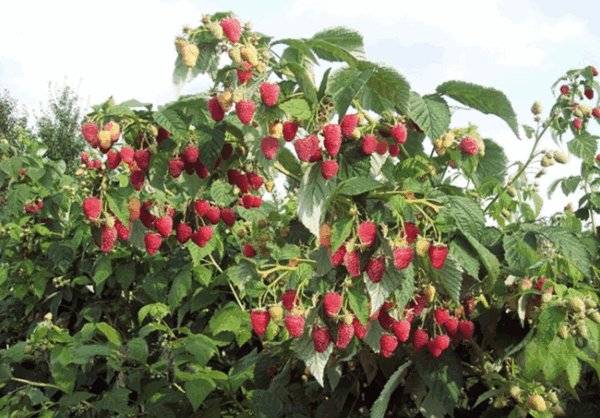Content
Raspberries have been cultivated in Russia for a long time, from the chronicles it is known that Yuri Dolgoruky also laid the first raspberries at the foundation of the future capital - Moscow. In what directions has raspberry breeding not developed since those ancient times. Gardeners learned about the yellow and black fruits of raspberries, about berries, almost the size of a plum, and about varieties that are capable of producing up to 5-6 kg of berries from one bush. In recent decades, it has become fashionable to grow berry bushes in the form of trees - standard black, red and golden currants, yoshta and even gooseberries have appeared. This fashionable trend could not bypass raspberries.
More than 20 years ago, the first so-called standard raspberry varieties appeared, one of the classic representatives of which is raspberries Strong guy.
Standard varieties or raspberry trees
A trunk is usually called a tree trunk without leaves from the roots to the beginning of crown growth. In principle, from almost any variety of raspberries, especially remontant, you can create a standard form - the so-called crimson tree... But at the end of the last century, scientific breeders managed to bring out special varieties of raspberries, distinguished by especially strong and thick shoots that grow exceptionally straight.
Of course, this raspberry is still far from the trees, it grows as an ordinary upright bush. But the main feature of these varieties is that, upon reaching a certain height, the shoots begin to actively branch and a large number of fruit branches are formed on them, imitating the crown of a tree.
Raspberry Krepysh can also grow in the form of a raspberry tree, as can be clearly seen in the next video.
Description of the variety
Raspberry Krepysh was obtained at the turn of the XX-XXI centuries by breeders under the guidance of the famous professor V. Kichina in the nurseries of VSTISP, at the Kokinsky base located in the Bryansk region. The variety was not included in the State Register of Russia for some unknown reason.
The bushes are of the standard type, reaching a height of 1.5 -1.8 meters. The variety fully justifies its name, since not only the central trunk, but also the rest of the shoots are very strong and thick. They are characterized by dense wood and, as a rule, should not bend either from strong winds or from the severity of crops, therefore they do not need supports, trellises and a garter.
But, judging by the reviews of gardeners who planted Krepysh raspberries on their plots, if the plot is not protected from the winds, then untied raspberry bushes may even break from strong winds.
Therefore, each gardener for his site must individually decide the issue of supports and a garter.
The big advantage of Krepysh raspberry is the complete absence of thorns, which greatly facilitates the task of picking berries. And for pruning, and for other care, the studless raspberry is very easy to handle.
Annual shoots have a juicy green tint; in the second year of life, their color changes to yellowish. Leaves on the shoots begin to grow about 30-40 cm above the soil surface. They have a highly corrugated sheet plate and are dark green in color. At the top of the bush, the leaves are often arranged in a crowded bunch.
Raspberry Krepysh is able to form a stem, first of all, due to short internodes, especially in the upper part of the shoots.In general, fruit twigs are formed exclusively in the upper part of the bush. They are compact, short, and quite a lot of them are formed. Moreover, with the help of correct pruning, their number can be increased even more, thereby contributing to an increase in the yield by 1.5-2 times.
Krepysh raspberry bushes give very little root growth, especially in the first years after planting. Therefore, propagation of the bush with the help of root suckers is rather difficult. But you don't have to devote a lot of time to dealing with uncontrolled growth, which often clogs up the site when growing other varieties of raspberries.
The berries are formed in the form of inflorescences, but at the same time they ripen very unevenly. In one cluster, consisting of 6-9 berries, there can be only one ripe - the rest can ripen for one to two weeks. Such stretched fruiting is good for a summer resident-gardener who grows raspberries for his own needs. For commercial cultivation, uncooked ripening of berries will be unprofitable.
Raspberry Krepysh can be called mid-season - the ripening period for this variety falls on the second half of June - July. By the way of fruiting, it belongs to the usual non-repairable varieties of raspberries, that is, the berries ripen only on the shoots of the last year.
As for the yield, the Krepysh raspberry is superior in this respect to some other varieties of standard raspberry, for example Tarusa... With a competent approach to business from one bush, you can get up to 4 - 4.5 kg of berries.
The frost resistance of the bushes is quite decent, Krepysh is able to withstand in winters with little snow up to -30 ° C. But in many regions of Russia, where winter temperatures easily exceed this mark, the variety will require shelter for the winter. And for this, the bushes must first be bent to the ground, which, given their thickness and strength, is not an easy task. Therefore, among gardeners there is an opinion that standard raspberry varieties, including Krepysh, are more suitable for regions with not very harsh winters.
Quite good resistance to most viral and fungal diseases is an undoubted advantage of the Krepysh raspberry variety. In general, he is quite unpretentious to growing conditions and will delight you with good yields if you provide him with the correct and appropriate pruning.
Characteristics of berries
Krepysh raspberries have the following characteristics:
- Their shape is beautiful, elongated, slightly blunt-conical, in the form of a cap.
- The pulp is dense, the fruits are well separated from the stalks, but when they are roughly harvested, they can crumble into their constituent elements.
- The separation of berries is dry; during transportation, raspberries do not particularly wrinkle and do not flow.
- The color of the berries is bright red, the surface is not shiny.
- Raspberry berries Krepish are quite large in size, reaching a weight of 7-10 grams.
- Berries retain their presentation for quite a long time.
- After ripening, they can hang on branches for a relatively long time, without crumbling, but gradually drying out.
- The taste is sweet with a slight sourness. The taste and marketability of Krepysh raspberry berries depend to a fairly large extent on the composition of soils and their fertility.
- The use of raspberries Krepysh is universal - they are well suited for making jam, confiture, jelly, compotes and other culinary preparations.
Care features: pruning
Perhaps the most important thing in what the care of standard raspberries differs from ordinary varieties is the features of pruning bushes. In principle, if one-year-old or freshly planted shoots are left completely without pruning, then by autumn their length will reach from 1.5 to 2 meters, after which their growth will slow down. And in the upper part of the stems, 3-4 small lateral shoots are formed, on which fruit branches will form next year. You can harvest the crop anyway, and the shape of a small raspberry tree by the bush will remain, but correct pruning can help increase the yield of raspberries and make the shape more pronounced.
Traditionally, it is advised to cut or pinch the top of the annual shoots of standard raspberries when their height reaches 1.5 meters. But shoots often reach a similar height by the end of summer, when all growth processes are already inhibited and, as a result of lateral shoots, a little is formed and they will not have time to mature well by winter.
The following approach to pruning standard raspberries should be considered more reasonable. Approximately at the end of May - beginning of June, when the shoots reach a height of 60-100 cm (depending on the growing region), the tops are shortened by 10-15 cm.During this period of active growth of the green mass, lateral shoots begin to form from all buds and have time well grow and take shape before winter comes. The number of shoots formed can grow up to 10-15 or even more. In the second half of summer, the tips of the shoots can be pinched again for additional branching. In the autumn, when all the foliage has fallen off, the bushes will look almost like real trees - on a fairly high trunk - from 7 to 12 flowing branched shoots. And next year, all these side shoots will be strewn with raspberries.
You can learn more about pruning Krepysh stock raspberries from the following video.
After fruiting, all two-year-old shoots should be completely cut out so as not to take away the strength to form young one-year branches.
Gardeners reviews
Gardeners leave ambiguous reviews about the standard raspberry varieties in general, and about the Krepysh variety in particular. Perhaps this is due to improper pruning of bushes, the whimsicality of the variety to soil conditions, or simply the unsuitability of a particular region for growing this variety of raspberries.
Conclusion
Despite some inconsistencies in the description of the reality variety, the Krepysh raspberry is worthy of decorating a small area where there is little free space. It does not require intensive care from you, but it will bring variety to the garden life.

